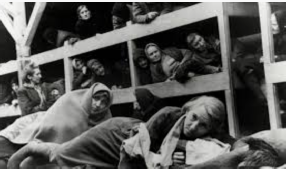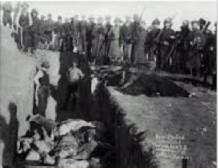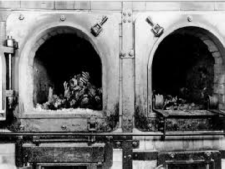|
CLICK BUTTON TO GO |
|
|
|
|
|
|
|
|
|
|
|
|
|
Videos |
|
|
|
|
|
|
|
|
|
|
|
|
|
PART 1 T O P I C |
|
|
|
|
|
|
|
|
|
|
|
|
|
|
|
|
|
|
JewishWikipedia.info
NAZI PLUNDER
Wikipedia
Nazi plunder refers to art theft and other items stolen as a result of the organized looting of European countries during the time of the Third Reich by agents acting on behalf of the ruling Nazi Party of Germany. Plundering occurred from 1933 until the end of World War II, particularly by military units known as the Kunstschutz, although most plunder was acquired during the war. In addition to gold, silver and currency, cultural items of great significance were stolen, including paintings, ceramics, books, and religious treasures. Although most of these items were recovered by agents of the Monuments, Fine Arts, and Archives program (MFAA, also known as the Monuments Men), on behalf of the Allies immediately following the war, many are still missing. There is an international effort underway to identify Nazi plunder that still remains unaccounted for, with the aim of ultimately returning the items to the rightful owners, their families or their respective countries.
BACKGROUND
Adolf Hitler was an unsuccessful artist who was denied admission to the Vienna Academy of Fine Arts. Nonetheless, he thought of himself as a connoisseur of the arts, and in Mein Kampf he ferociously attacked modern art as degenerate, including Cubism, Futurism, and Dadaism, all of which he considered the product of a decadent twentieth century society. In 1933 when Hitler became Chancellor of Germany, he enforced his aesthetic ideal on the nation. The types of art that were favored amongst the Nazi party were classical portraits and landscapes by Old Masters, particularly those of Germanic origin. Modern art that did not match this was dubbed degenerate art by the Third Reich, and all that was found in Germany's state museums was to be sold or destroyed. With the sums raised, the Führer's objective was to establish the European Art Museum in Linz. Other Nazi dignitaries, like Reichsmarschall Hermann Göring and Foreign Affairs minister von Ribbentrop, were also intent on taking advantage of German military conquests to increase their private art collections
SALE OF ART CONFISCATED FROM GERMAN MUSEUMS
Art dealers Hildebrand Gurlitt, Karl Buchholz, Ferdinand Moeller and Bernhard Boehmer set up shop in Schloss Niederschonhausen, just outside Berlin, to sell a cache of near-16,000 paintings and sculptures which Hitler and Göring removed from the walls of German museums in 1937-38. They were first put on display in the Haus der Kunst in Munich on 19 July 1937, with the Nazi leaders inviting public mockery by two million visitors who came to view the condemned modern art in the Degenerate Art Exhibition. Propagandist Joseph Goebbels in a radio broadcast called Germany's degenerate artists "garbage". Hitler opened the Haus der Kunst exhibition with a speech. In it he described German art as suffering "a great and fatal illness".
PUBLIC BURNING OF ART
Hildebrand Gurlitt and his colleagues did not have much success with their sales, mainly because art labelled "rubbish" had small appeal. So on 20 March 1939 they set fire to 1,004 paintings and sculptures and 3,825 watercolours, drawings and prints in the courtyard of the Berlin Fire Department, an act of infamy similar to their earlier well-known book burnings. The propaganda act raised the attention they hoped. The Basel Museum in Switzerland arrived with 50,000 Swiss francs to spend. Shocked art lovers came to buy. What is unknown after these sales is how many paintings were kept by Gurlitt, Buchholz, Moeller and Boehmer and sold by them to Switzerland and America - ships crossed the Atlantic from Lisbon - for personal gain.
PUBLIC AUCTIONS AND PRIVATE SALES IN SWITZERLAND
The most infamous auction of Nazi looted art was the "degenerate art' auction organized by Theodor Fischer (auctioneer) in Lucerne, Switzerland, 30 June 1939 at the Grand Hotel National. The artworks on offer had been "de-accessioned" from German museums by the Nazis, yet many well known art dealers participated as well as proxies for major collectors and museums. Public auctions were only the visible tip of the iceberg, as many sales operated by art dealers were private. The Commission for Art Recovery has characterized Switzerland as "a magnet" for assets from the rise of Hitler until the end of World War II. Researching and documenting Switzerland's role "as an art-dealing centre and conduit for cultural assets in the Nazi period and in the immediate post-war period" was one of the missions of the Bergier Commission, under the directorship of Professor Georg Kreis.
NAZI LOOTING ORGANIZATIONS
While the Nazis were in power, they plundered cultural property from every territory they occupied. This was conducted in a systematic manner with organizations specifically created to determine which public and private collections were most valuable to the Nazi Regime. Some of the objects were earmarked for Hitler's never realized Führermuseum, some objects went to other high-ranking officials such as Hermann Göring, while other objects were traded to fund Nazi activities.
In 1940, an organization known as the Einsatzstab Reichsleiter Rosenberg für die Besetzten Gebiete (The Reichsleiter Rosenberg Institute for the Occupied Territories), or ERR, was formed, headed for Alfred Rosenberg by Gerhard Utikal. The first operating unit, the western branch for France, Belgium and the Netherlands, called the Dienststelle Westen (Western Agency), was located in Paris. The chief of this Dienststelle was Kurt von Behr. Its original purpose was to collect Jewish and Freemasonic books and documents, either for destruction, or for removal to Germany for further "study". However, late in 1940, Hermann Göring, who in fact controlled the ERR, issued an order that effectively changed the mission of the ERR, mandating it to seize "Jewish" art collections and other objects. The war loot had to be collected in a central place in Paris, the Museum Jeu de Paume. At this collection point worked art historians and other personnel who inventoried the loot before sending it to Germany. Göring also commanded that the loot would first be divided between Hitler and himself. Hitler later ordered that all confiscated works of art were to be made directly available to him. From the end of 1940 to the end of 1942 Göring traveled twenty times to Paris. In the Museum Jeu de Paume, art dealer Bruno Lohse staged 20 expositions of the newly looted art objects, especially for Göring, from which Göring selected at least 594 pieces for his own collection. Göring made Lohse his liaison-officer and installed him in the ERR in March 1941 as the deputy leader of this unit. Items which Hitler and Göring did not want were made available to other Nazi leaders. Under Rosenberg and Göring's leadership, the ERR seized 21,903 art objects from German-occupied countries.
Other Nazi looting organizations included the Sonderauftrag Linz, the organization run by the art historian Hans Posse, which was particularly in charge of assembling the works for the Führermuseum, the Dienststelle Mühlmann, operated by Kajetan Mühlmann, which Göring also controlled and operated primarily in the Netherlands, Belgium, and a Sonderkommando Kuensberg connected to the minister of foreign affairs Joachim von Ribbentrop, which operated first in France, then in Russia and North Africa. In Western Europe, with the advancing German troops, were elements of the 'von Ribbentrop Battalion', named after Joachim von Ribbentrop. These men were responsible for entering private and institutional libraries in the occupied countries and removing any materials of interest to the Germans, especially items of scientific, technical or other informational value.
Art collections from prominent Jewish families, including the Rothschilds, the Rosenbergs, the Wildensteins and the Schloss Family were the targets of confiscations because of their significant value. Also Jewish art dealers sold art to German organizations - often under duress, e.g. the art dealerships of Jacques Goudstikker, Benjamin and Nathan Katz and Kurt Walter Bachstitz. Also non-Jewish art dealers sold art to the Germans, e.g. the art dealers De Boer and Hoogendijk in the Netherlands.
By the end of the war, the Third Reich amassed hundreds of thousands of cultural objects.
FÜHRERMUSEUM
Main article: Führermuseum
After Hitler became Chancellor, he made plans to transform his home city of Linz, Austria into the Third Reich's capital city for the arts. Hitler hired architects to work from his own designs to build several galleries and museums, which would collectively be known as the Führermuseum. Hitler wanted to fill his museum with the greatest art treasures in the world, and believed that most of the world's finest art belonged to Germany after having been looted during the Napoleonic and First World wars.
HERMANN GÖRING COLLECTION
The Hermann Göring collection, a personal collection of Reichsmarschall Hermann Göring, was another large collection including confiscated property, consisted of approximately 50 percent of works of art confiscated from the enemies of the Reich. Assembled in large measure by art dealer Bruno Lohse, Göring's adviser and ERR representative in Paris, in 1945 the collection included over 2,000 individual pieces including more than 300 paintings. The U.S. National Archives and Records Administration's Consolidated Interrogation Report No. 2 states that Göring never crudely looted, instead he always managed "to find a way of giving at least the appearance of honesty, by a token payment or promise thereof to the confiscation authorities. Although he and his agents never had an official connection with the German confiscation organizations, they nevertheless used them to the fullest extent possible."
NAZI STORAGE OF LOOTED OBJECTS
The Third Reich amassed hundreds of thousands of objects from occupied nations and stored them in several key locations, such as Musée Jeu de Paume in Paris and the Nazi headquarters in Munich. As the Allied forces gained advantage in the war and bombed Germany's cities and historic institutions, Germany "began storing the artworks in salt mines and caves for protection from Allied bombing raids. These mines and caves offered the appropriate humidity and temperature conditions for artworks." Well known repositories of this kind were mines in Merkers, Altaussee and Siegen. These mines were not only used for the storage of looted art but also of art that had been in Germany and Austria before the beginning of the Nazi rule. Degenerate art was legally banned by the Nazis from entering Germany, and so ones designated were held in what was called the Martyr's Room at the Jeu de Paume. Much of Paul Rosenberg's professional dealership and personal collection were so subsequently designated by the Nazis. Following Joseph Goebels earlier private decree to sell these degenerate works for foreign currency to fund the building of the Führermuseum and the wider war effort, Hermann Göring personally appointed a series of ERR approved dealers to liquidate these assets and then pass the funds to swell his personal art collection, including Hildebrand Gurlitt. With the looted degenerate art sold onwards via Switzerland, Rosenberg's collection was scattered across Europe. Today, some 70 of his paintings are missing, including: the large Picasso watercolor Naked Woman on the Beach, painted in Provence in 1923; seven works by Matisse; and the Portrait of Gabrielle Diot by Degas.
HOLOCAUST REPARATIONS
NAZI PLUNDER



THE
INCREDIBLE
STORY OF THE JEWISH PEOPLE
